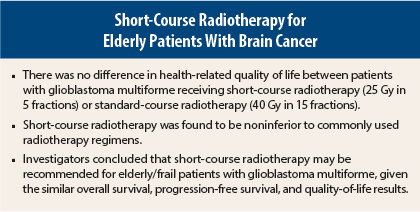No difference in overall survival or progression-free survival was observed between elderly and/or frail patients undergoing short and standard courses of radiotherapy for glioblastoma multiforme, according to data presented by Elena Fidarova, MD, at the 2015 Multinational Association of Supportive Care in Cancer (MASCC)/International Society of Oral Oncology (ISOO) Annual Meeting on Supportive Care in Cancer in Copenhagen.1
“The short radiotherapy regimen may be recommended as a treatment option for elderly and/or frail patients given the similar overall survival, progression-free survival, and quality-of-life results,” said Dr. Fidarova, a radiation oncologist at the International Atomic Energy Agency (IAEA) in Vienna.
“For patients in poor condition, such as the elderly or frail, a short course of radiotherapy is very beneficial, especially in some countries where there are problems with transporting patients to receive their radiotherapy,” said Sebastiano Mercadante, MD, moderator of the session and Director of the Anesthesia and Intensive Care Unit, Pain Relief and Palliative Care Unit, La Maddalena Clinic for Cancer, Palermo, Italy. “So having information about the similarity of efficacy of a short course in comparison with a traditional course is very important.”
Study Population and Methods
Dr. Fidarova and her colleagues at the IAEA conducted a phase III, international multicenter, prospective, noninferiority study on 98 patients randomized to receive radiotherapy as either 25 Gy delivered in five fractions (n = 48) or 40 Gy delivered in 15 fractions (n = 50). The study aimed to evaluate overall survival, progression-free survival, and health-related quality of life.
Patients were stratified by age (< 65 or ≥ 65), Karnofsky Performance Score, and extent of surgical resection. Of the 98 patients randomized, 96 were eligible for health-related quality-of-life analysis: 47 in the short-course and 49 in the standard-course radiotherapy groups.
Patients aged ≥ 50 years with a Karnofsky Performance Score of between 50% and 70% were classified as “frail,” patients aged ≥ 65 years with a Karnofsky Performance Score of between 50% and 70% were classified as “elderly and frail,” and those aged ≥ 65 years with a Karnofsky Performance Score of between 80% and 100% were classified as “elderly.”
The study population presented with newly diagnosed glioblastoma multiforme (World Health Organization grade IV) and had undergone no previous chemotherapy or radiotherapy. Their initial surgery/biopsy at diagnosis had to be performed within 6 weeks prior to randomization, and initiation of treatment radiotherapy began within 2 weeks of randomization.
The European Organisation for Research and Treatment of Cancer (EORTC) core questionnaire (QLQ-C30), in combination with the brain module QLQ-BN20 and the Mini Mental Status Examination (MMSE), was administered to patients at baseline, 4 weeks after completion of radiotherapy, and every 3 months thereafter until disease progression.
Health-Related Quality of Life
“The response rate was quite high and comparable in the two groups,” said Dr. Fidarova. In the short-course [radiotherapy] group, the response rate was 96% at baseline, 86% at 1-month follow-up, and 85% at 4-month follow-up; in the standard-course cohort, it was 98% at baseline, 63% at 1-month follow-up, and 62% at 4-month follow-up.
The median overall survival was 7.9 months in the short-course radiotherapy group and 6.4 months in the standard-course radiotherapy group (P = .988). The median progression-free survival was 4.2 months in both arms.
“The response rate dropped significantly by the fourth follow-up, which is understandable given the median [progression-free survival] and [overall survival],” Dr. Fidarova added. By the fourth follow-up, response rates fell to 29% and 22% in the short- and standard-course cohorts, respectively.
Dr. Fidarova and her colleagues observed no difference between study arms in global quality of life/main function scales/symptoms, except in the category of insomnia. An improvement was observed in both arms at 4 months of follow-up in the categories of global quality of life, social and physical function, fatigue, and insomnia but was only significant for insomnia in the short-course radiotherapy group.
At study end, investigators found no difference in health-related quality of life between the two arms. They concluded that short-course radiotherapy was noninferior to commonly used radiotherapy for elderly and/or frail patients with glioblastoma multiforme. ■
Disclosure: This study was coordinated and funded by the IAEA under the IAEA Coordinated Research Activities.
Reference
1. Fidarova E, Ghosh S, Kepka L, et al: Quality of life in elderly/frail patients with glioblastoma multiforme: Results of the IAEA randomized phase III study comparing short and standard course of radiotherapy. 2015 Multinational Association of Supportive Care in Cancer/International Society of Oral Oncology Annual Meeting on Supportive Care in Cancer. Abstract 22-1-O. Presented June 26, 2015.


